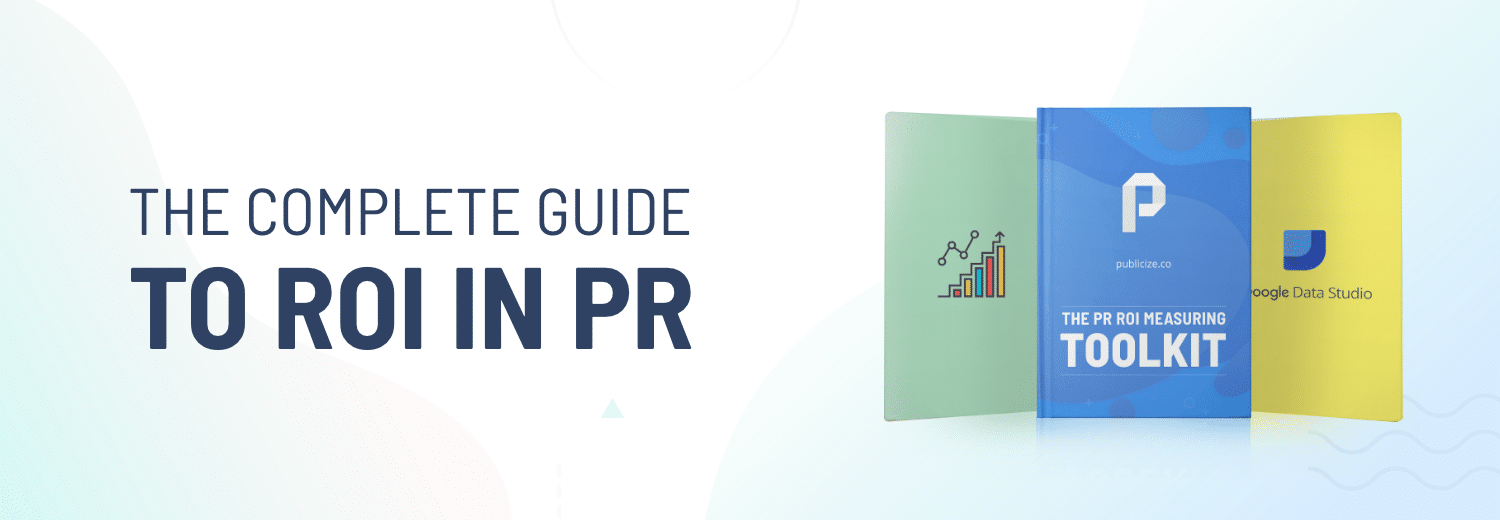‘Return on investment’ can feel like business buzzwords.
When we’re talking about ROI, don’t we just mean profitability?
Well, to some degree, yes.
What does ROI (return on investment) mean?
Investopedia describes ROI as a performance measure used to “evaluate the efficiency of an investment”.
However, when it comes to public relations , PR ROI isn’t solely about nickels and dimes.
Short-term cash gains from your investment are one measure for pr value, but the long-term gains from greater exposure and increased industry credibility can’t be underestimated.
Calculating PR ROI on such gains can be difficult, so we’ve arranged this useful guide to show how best to measure and use ROI in your digital PR strategy.
In this guide, we’ll be covering:
- What is ROI in PR
- ROI for PR today
- How to measure PR ROI
- How are we measuring PR ROI?
- How to track PR ROI long term?
- Conclusion
What is ROI in PR?
Picking up from where we left off in the intro, ROI and PR don’t have to be like oil and water. For us, ROI in PR tells you the short-term and/or long-term profitability of a specific PR strategy.
ROI in PR can be split in two categories:
- Monetary gains like sales revenue increases, directly attributable to a PR strategy. This could be an email blast persuading leads to sign up for a sales call by providing them a free piece of valuable content.
- Earned media gains that heighten a startup’s industry credibility and/or reputation, indirectly contributing to monetary gains like sales revenue increases. This could be an interview with a highly regarded and relevant publication, promoting a startup to a large and interested readership.
Most businesses, big and small, know about number one. In fact, it’s common that’s all they care about. Yet our experience has taught us that neglecting the second is massively detrimental to understanding the success of the first.
If you want to see an accurate ROI on your PR strategy, it’s vital to consider both of these.
ROI for PR today
In the current PR landscape, there’s much debate over how ROI should be measured, and little consensus over what actually constitutes it as a metric.
On one hand, measurement tools such as impressions and media mentions provide some sense of a PR campaign’s efficacy. However, without contextualising these numbers around well-defined strategy goals, they prove themselves to be meaningless.
Moreover, many startups analyzing their initial PR value make the big mistake of only considering site sessions or publication appearances as the parameters to measuring pr success. The reality is that these metrics could lead you to believe your PR campaign is going far better or worse than is actually the case.
For example, if your site is creating content that’s specifically designed to build social proof like a podcast, looking at the amount of content impressions would probably be uninformative.
Why is that?
Well, a podcast is designed to show your startup’s expertise in it’s given field. Sure it can be used to bring more exposure to your startup, but this is secondary to the industry credibility podcasts add. A better measure for pr value in this case would be lead conversion rate.
Giving data a framework that describes a PR strategies’ purpose is the only way to correctly use them in measuring pr success.
Here are some different metrics you may track to measure the ROI of your media coverage and PR campaigns:
- Page Impressions – Every time a page on your site appears on a Google ad or SERP.
- Page Views – Every time a page on your site is clicked on a Google ad or SERP.
- Page Click Through Rate – The ratio of page impressions to page views
- Social Media Likes/Shares – The amount of interactions visitors have with one of your social media posts.
- Bounce Rate – The ratio of single page sessions on your site to multiple page sessions.
- Average Page View Duration – The average time visitors spent on a particular page.
- Goal Conversions – The number of measurable goals completed, such as scheduled calls.
To nail PR KPI measurement, you need SMART goals.
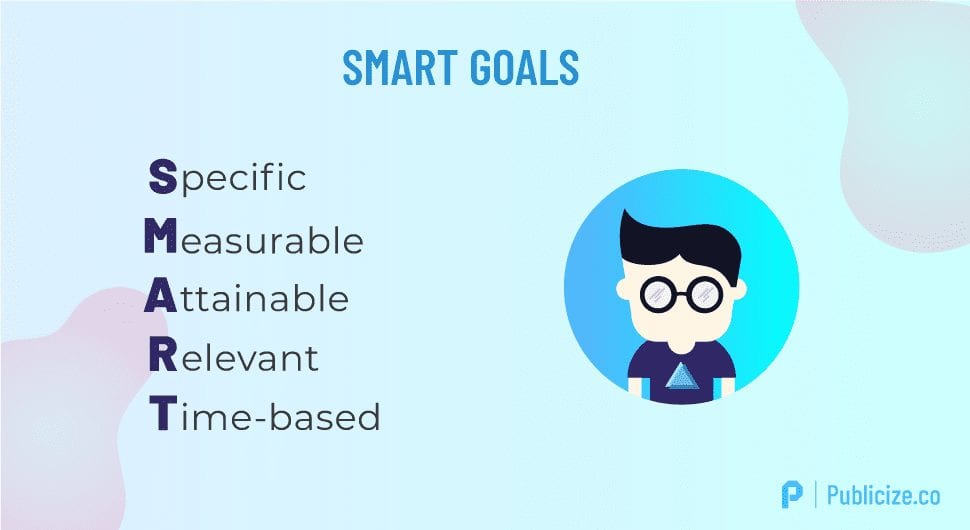
Startups need to become increasingly ‘SMART’ when it comes to choosing how they plan to measure ROI in PR. For instance:

How to measure PR ROI
There are currently two established strategies for measuring ROI in public relations : Barcelona principles of pr measurement and Advertising value equivalency.
Barcelona principles of pr measurement
Companies that don’t abide by this rule will usually find there is little to no ROI with this activity. They will also suffer from opportunity cost, as their resources could have been put to better use on other PR and marketing activities that would have provided a better return.
Set out in seven principles of pr measurement, Barcelona Declaration of Measurement is designed to assess PR campaign efficiency.
It has been adopted by over 200 delegates in over 30 countries from institutions such as AMEC, the Global Alliance and the Institute for Public Relations.
It has become the standard for measuring PR success used by consultants and agencies around the world.
How has it achieved this feat?
By setting out a model for proving tactic performance and nurturing continuous improvement. The Barcelona Declaration has also not been left behind by the increased emergence of digital PR. The original principles of pr measurement developed in 2010 were reformed in 2015 in order to keep pace with the PR industry’s ever-advancing technologies.
Why are these principles effective?
Barcelona principles of pr measurement crystallize the importance of measurable goals. It places emphasis on achievements being as quantifiable as possible. It does this without discounting less attainable metrics, like industry credibility, as important indicators of success.
Additionally, they take into account new technological phenomena such as social media and fully regard their role in ROI PR. Social media deserves the same analytical attention as monetary ROI for PR strategy.
What are these principles lacking?
In short, the principles don’t make concrete steps towards standardizing a framework of ROI PR calculation.
In spite of their clear support for quantifying returns on PR in a meaningful way, the principles don’t enable startups with mathematical formulae to draw objective conclusions from their PR efforts.
Advertising Value Equivalency (AVE)
The more antiquated of the two, AVE was developed in the early 1940s as a crude method of quantifying all ROI activity.
So how does advertising value equivalency measure ROI in PR?
It multiplies the amount of ad space or seconds mentioned on a broadcast network by the medium’s advertising rate.
Why is AVE flawed?
The advertising value equivalency, although still used by some agencies, is a particularly outdated system for assessing PR ROI.
Here are a couple of reasons why:
- The AVE formula tries to put a dollar value on every type of promotional activity done to increase a business’s exposure and client base. Modern day PR campaigns are much more than profit/loss analysis. It fails to take into account the KPIs of what a specific PR tactic is trying to achieve, and who it’s trying to target.
- AVE fails to take into account the relevancy of a PR win. For example, if you get a mention on a fintech online publication but your PR campaign is for a product centered around health and wellness, the mention is worth very little.
How are we measuring PR ROI?
From day one, we look beyond the monetary value of the PR we do.
Firstly, it can be difficult to put a dollar value on every action taken. The fine art of creating a bomb PR strategy has to consider unquantifiable influences like desire and preference.
How do we get around this?
We use a robust specification when defining our goals for a given task. By asking ourselves how can we best measure the success of a particular action – considering SMART requirements – we have clear unified ideas of what success looks like.
Here are some of the factors we focus on when measuring the ROI of our PR campaigns:
Earned media
Why is earned media a good measure of PR ROI?
We see earned media as pivotal for generating interest in your company, regardless of where they are in your purchase funnel.
Here are a few reasons why many see earned media as the most valuable jigsaw piece in the digital PR puzzle:
The more times a reader sees a business’ name in published online content, the more likely they are to click on the site and begin a relationship with that business.
They may not become a customer straight away, but they will enter somewhere at the top of the purchase funnel. Then, potentially invest in your product or service in the future.
Yes, earned media’s impact can be a little tricky to measure. However, it contributes massively to your long term PR goals like building brand reputation and awareness.
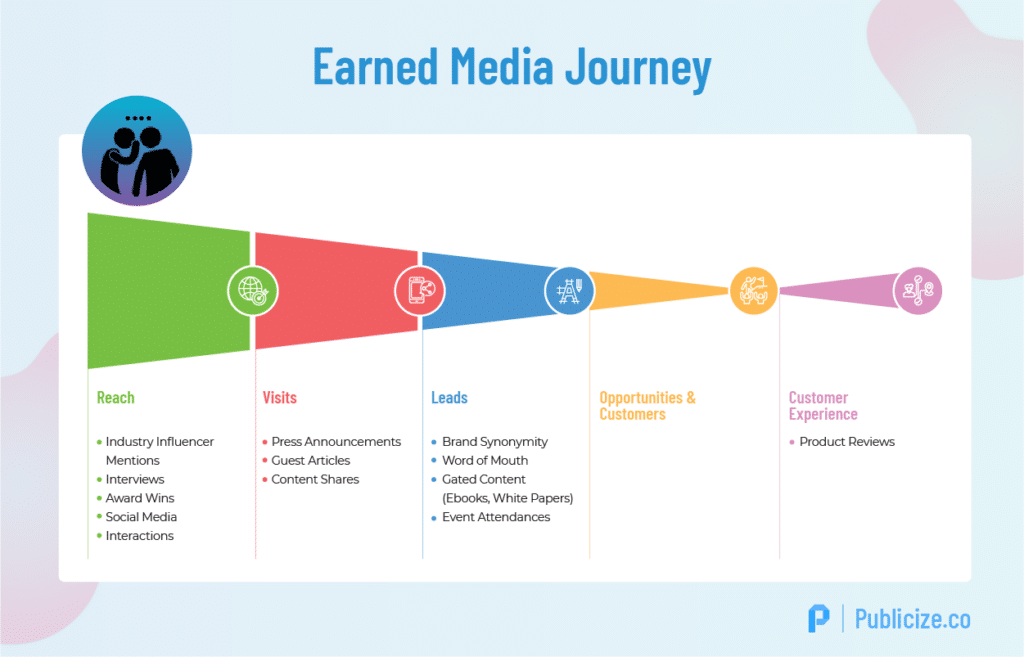
How do we measure earned media’s ROI?
The exact structure of a press release is always determined by what you’re actually announcing. For example, a startup launch will differ from a new partnership.
But whatever it is you’re announcing, a well-written press release always follows a recognizable format, which looks like this.
To unpack this question, let’s use an example:
The ROI for a top-of-the-funnel guest blog can be measured by its reach and the subsequent exposure it brings to a business.
To elaborate further:
- How do we measure the reach? We look at the organic click-through rate (CTR) and page time for the guest article.
- How do we assess the engagement of each session? We consider metrics like average time on page and the article bounce rate.
A guest article with a low bounce rate and high average page time tells us that users are finding the content valuable and engaging with it well. As a result, we would label this piece of earned media as a success.
The PESO Model
While Earned Media is an important indicator of your ROI PR it cannot exist in isolation. An effective PR and marketing strategy requires a mixture of different content.
These include:
- Paid Media
- Earned Media
- Shared Media
- Owned Media
These four types of media all compliment each other. Together, they’re more commonly known as The PESO Model. This was developed by Gini Dietrich, author of Spin Sucks:
As you can see, an effective PR and marketing strategy needs to have these four types of media working in sync.
Earned media is a great indicator for ROI in PR, but don’t neglect your own content when measuring pr success.
Backlinks
Why are backlinks good measures of PR ROI?
The importance of backlinks when measuring PR ROI is unquestionable.
Essentially a backlink is a link that directs a user (back) to your website. Backlinks can be internal – like a link from your latest blog post to one your resource pages – or external – being a link coming from another site into your own.
Backlinks are the ideal metric to gauge your success on Google SERPs (Search Engine Results Page). However, not all backlinks are considered equal.
Backlinks from sites with high domain authority (we’ll come back to DA later) are especially valuable as Google sees those as credible and established websites regarding your work as a valid source of information. We say an external backlink that’s contextually relevant, and from a site with a DA score over 40 is valuable.
However, backlinks from sites with low DA scores and backlinks that are irrelevant can be considered toxic. Backlinks like these can harm rather than help the health of your site. That’s why doing semi-frequent backlink audits using programs such as Screaming Frog are important to maintaining your site’s value.
Furthermore, backlinks contribute to Google bots indexing your pages faster. If a Google bot crawls your site and finds that backlinks are plentiful, they’ll regard your content as trustworthy and index it higher on Google search pages.
Referral traffic received from a backlink will give you exposure to new users and potentially new markets you hadn’t previously considered.
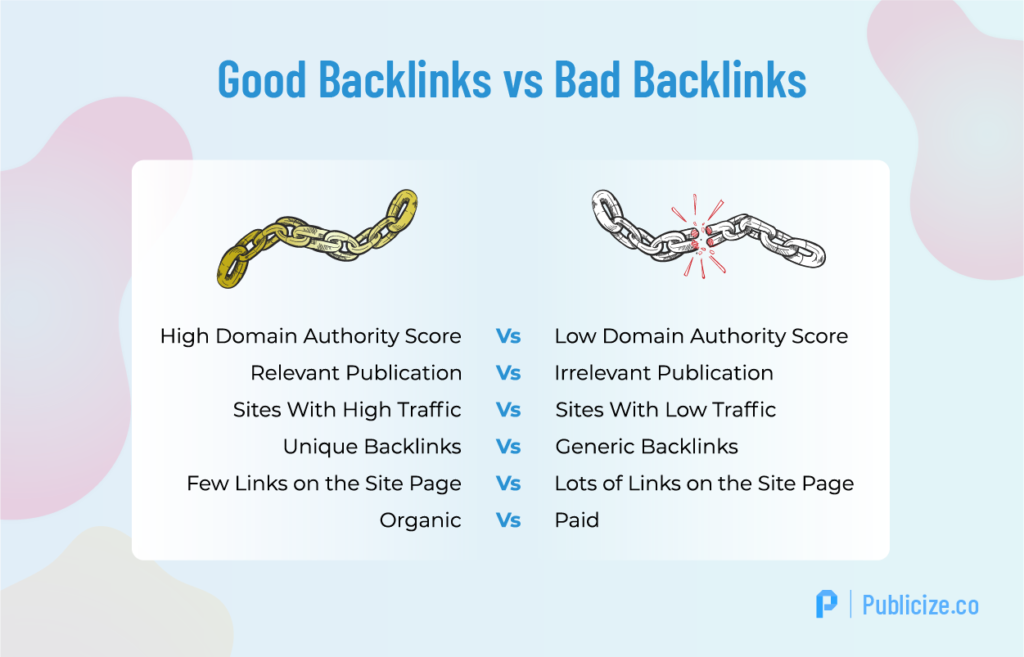
How do we measure backlinks’ ROI?
This seems tricky.
Backlinks that are embedded within online articles are usually linking to top of the sales funnel content (TOFU), making the ROI value seem blurry. However, the metrics used to measure TOFU content is actually what gives backlinks their ROI value.
Referral traffic is the most obvious measure of backlink ROI; the higher the traffic, the higher the ROI.
However, backlinks on tags at the end of guest articles are usually more likely to link to the middle of the sales funnel (MOFU) content.
How do we go about measuring the ROI value of MOFU content?
It can be best measured by more transactional metrics. These include goal conversions or lead/opportunity increases.
Legitimate link-building practices can see exponential increases to a site’s exposure and traffic, and although it’s not always easy to assess its monetary value, backlinking can be a great indicator of your website’s current status.
Domain authority and page authority (DA/PA)
Why are DA/PA changes good measures of PR ROI?
As mentioned above, DA and PA increases have a massive impact on your online reputation and brand awareness.
What are domain authorities and page authorities you ask?
Let’s break these down:
- Domain Authority – This indicates how well websites will “rank on Google SERPs”. Scaling as an integer from 1 to 100, a higher DA score predicts a better ability to rank well on Google search pages. ‘Domain’ refers to the principal URL of a site, like https://publicize.co/.
- Page authority – This shows how well a specific page of a website will “rank on Google SERPs”. Scaling the same as DA scores, PA scores are typically smaller than their respective DAs and are more comparative than absolute in their value. ‘Page’ refers to a specific URL belonging to a site like https://publicize.co/packages/.
So, why do changes to a site’s DA or PA matter if it doesn’t directly affect Google’s ranking of your content?
To understand this, we need to drill down into what these scores actually represent.
Take a weightlifter for example. Say they’re the 10th best weightlifter in the world. They work really hard all year and can now lift 300lb. If their competitors do the same or even better, the weightlifter will stay the same or even decrease in their ranking.
DA and PA changes are basically like this.
A website’s DA score doesn’t have absolute value but shows a comparative advantage over rival sites.
How do we measure DA/PA changes’ ROI?
Before measuring changes to DA and PA scores, we need to contextualize the value of a given change.
Changes are exponential. This means that going from a score of 1-2 is worth less than going from 2-3. This rule follows such that a change of 10-20 is significantly less than 40-50.
That’s all well and good, but how do you know the value of a DA or PA change?
SaaS SEO developers like Moz and SEMRush have their own secret recipes for determining the change in value of a DA or PA score, but there’s no industry measurement standard.
So, we decided to make our own.
We created the ROI DA function. This exponential function scales from 1 to 1000. It shows us the difference in the value of a change of 5-10 in comparison to 45-50. Now, we can attribute appropriate values to changes in authority scores.
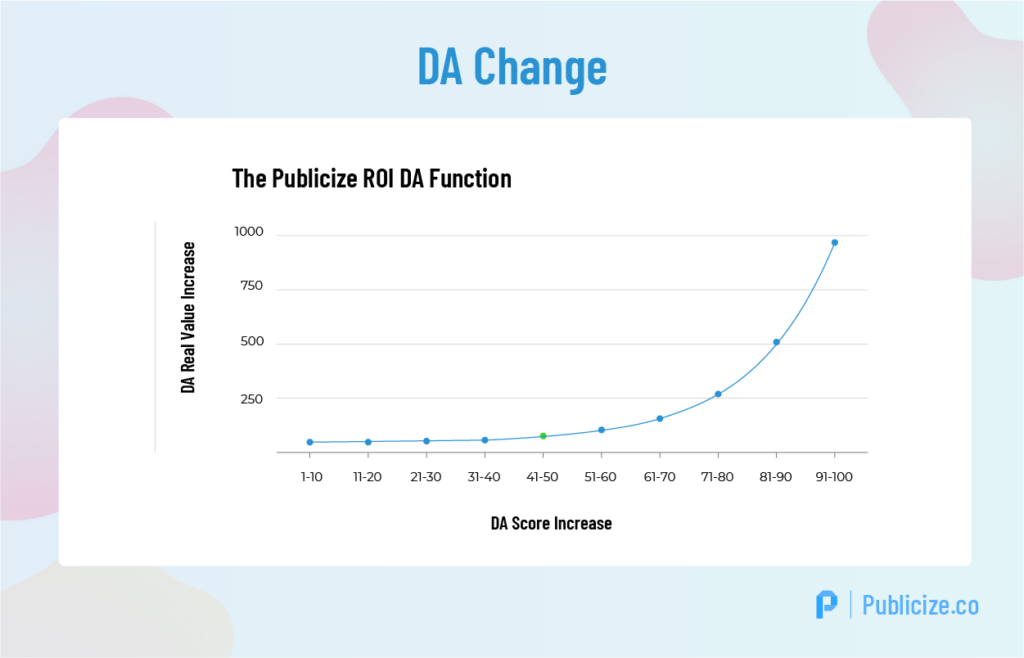
Social Media Posts
Why are social media posts good measures of PR ROI?
When it comes to creating a buzz around your startup, social media PR is king.
On top of appearing to be in the loop, social media platforms give startups:
- Increased organic visibility
- Improved traffic to website
- Heightened brand awareness
- Faster and easier communication
A dominant presence on platforms such as Instagram and Facebook significantly contributes to your startup’s reach and audience engagement, and this is measured through the amount of people sharing or positively reacting to your posts. If you want to know more about the right social media channel for your platform, take a look at how the five main channels compare below:

How do we measure social media PR ROI?
In essence, measuring the impact of social media comes down to setting SMART goals around what you want to achieve.
If you’re posting to encourage people to sign up to a newsletter or webinar, then consider the following metrics your key indicators of success:
- Signup conversions
- Impression to signup conversion rate
If your posts are more focused around increasing your site’s reach and increasing your brand awareness:
- Impressions
- Click-through rate
- Estimated Reach
- Social Media Mentions
How to track PR ROI long term?
So, we’ve talked about individual measures of ROI in your PR strategy, but how to measure pr success in the long run?
When we think of long-term PR ROI at Publicize we categorize three fields which indicate real ROI on a PR campaign.
Brand awareness and loyalty
Improvement in metrics like traffic and social media shares should show long-term increases in new business opportunities and securing existing business for new contracts.
Top of the sales funnel activities such as blog posts, guest articles and social media interactions all feed users through a process of site engagement, becoming leads, and converting into customers.
Industry credibility
It’s undeniable that being seen as a thought-leader or an industry expert tells consumers your startup is reliable and trustworthy. Earned media, such as podcast appearances or interviews build up your social proof which in turn increases the likelihood of attracting new business.
Middle of the sales funnel content such as gated content downloads inform the long-term ROI on the success of doing these types of PR activities.
Increasingly positive reputation
This sounds similar to industry credibility, but there’s a little difference.
What separates the two?
Building industry credibility is about showing your expertise and trustworthiness as a startup. However, increasing your positive reputation relies on good customer experience and how that’s transmitted to the world.
You might make some short-term gains in traffic and bringing in leads, but this doesn’t necessarily convert into long-term startup prosperity.
In terms of PR ROI, we look at the social media shares/likes on positive customer experience stories and audience engagement in press release announcements regarding customer milestones.
Wrapping up…
When you get down into the weeds of PR’s ROI, it’s easy to get lost. Putting your finger on the worth of the backlink from a guest article can seem impossible, making the whole ROI project feel like a guessing game.
It’s tough, we know.
Yet, when you take a step back and consider what good PR is trying to achieve, the returns become clear. However, it’s worth remembering that having directly attributable stats to the success of the exposure you’ve received is awesome, but not always possible.
It’s vital to have an understanding of the metrics you’re measuring for PR’s ROI. It helps you assess the short-term gains made and understand how you’ve come about your long-term achievements. Having a clear head on the purpose of each PR activity, as well as following the tips in this guide, will put you on sure footing when looking to successfully measure ROI in PR.



